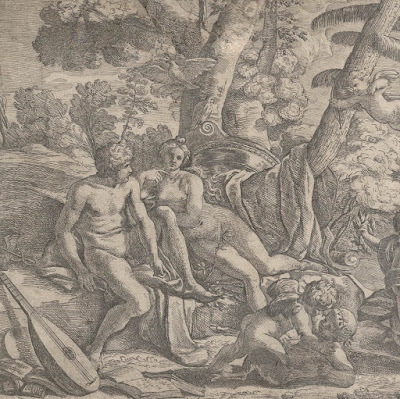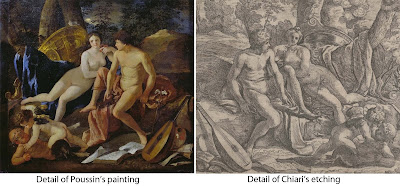Fabrizio Chiari (aka Fabrizio Claro; Fabritius Clarus) (c.1615–95)
“Venus and
Mercury”, 1636, after Nicolas Poussin’s (1594–1665) painting of the same name
that is now sectioned with the left side held in Dulwich Picture Gallery,
London, and the right side held in the Louvre, Paris.
Etching printed
with grey ink on buff coloured laid paper, trimmed to the image borderline and
lined onto a conservator’s support sheet and laid on heavy wove paper (Dutch
Etch).
Size: (sheet)
29.2 x 39.8 cm
Inscribed with
the artist’s name and dated on the tablet at lower left: “FABRITI / CHIARVS / ex 1636"
Inscribed
with the inventor’s name on the open book at the lower left centre: “NICOLAIS /
PVSSIN / VS / IN”
Wildenstein
1955 121.I (Georges Wildenstein 1955, “Les Graveurs de Poussin au XVIIe siècle”,
Gazette des Beaux-Arts, XLVI, Paris); Andresen 1863 348.I (A. Andresen 1863, “Nicolaus
Poussin - Verzeichniss der nach seinen Gemälden Gefertigten...”, Leipzig); LeBlanc
2 (Ch. Leblanc 1854 [-89], “Manuel de l'amateur d'estampes, contenant un
dictionnaire des graveurs de toutes les nations …”, dl. 2, p. 11, cat.nr. 2).
The British
Museum offers the following description of this print:
“Venus and
Mercury, after Poussin: Venus, reclining beneath clump of trees, with Mercury
seated at her side, at left; at their feet, Cupid wrestling a young satyr; at
right, group of five putti singing and playing music. 1636 Etching”
The Rijksmuseum
offers the following description of this print (note that there is an anomaly in
the description of this print with that offered by the BM):
“Venus and
Mercury are in a landscape. In the foreground is a putto in a fight with a
young satyr. A putto with two wreaths in his hands watching. Left, a group of
music-making putti. In the foreground on the right a lute.” (http://hdl.handle.net/10934/RM0001.COLLECT.92875)
Condition: good
impression but with numerous restorations and replenishing of losses, trimmed at
the image borderline and laid on two conservator’s support sheets.
I am selling
this softly glowing etching for the total cost of [deleted] including postage and handling to anywhere
in the world.
If you are
interested in purchasing this rare old-master print and an important historical
document of a Poussin painting that is now only to be seen in pieces, please
contact me (oz_jim@printsandprinciples.com) and I will send you a PayPal
invoice to make the payment easy.
This etching is
a curious print that I have not completely come to terms with.
First, it is
printed in a cool grey ink on warm grey toned paper. Second, and the most
curious issue for me, the description of the copy that the British Museum holds
advises that “… at right, group of five putti singing and playing music.” The
BM does not post an image of their print but this description fits perfectly
with the print that I’m showing here … but there is a perplexing problem: the Rijksmuseum
shows the print in reverse and describes their print with the music-making
puttie as being on the left. Neither august institution is likely to be wrong as
both mirrored impressions are identical (i.e. neither is a copy) but why is
there this anomaly?
In a way, my
first conundrum about the grey toning of the print is probably the answer. This
and the copy in the BM (which I am unable to see to confirm my thoughts) is a counterproof
(i.e. a print taken from the “original” etching when it was still sticky and
wet after being pulled from the press by placing the original etching onto second
sheet of paper and rolling both sheets back through the press to create a
mirror image of the original on the second sheet). This would account for the
grey appearance of the print. Do I know for sure? No I don’t as the impression
shown here is trimmed at the image borderline but before the platemark that
would have shown that it is in fact a counterproof. Moreover, the print has
been beautifully restored and in the process of this restoration the surface of
the print is fattened and so “tell-tale” signs of embossing from the etching plate
are not evident.
For those
interested in the portrayed subject of this print, the Dulwich Picture Gallery
which holds the left section of Nicholas Poussin’s painting, “Venus and
Mercury” (1627–29)—this etching shows Poussin’s complete design before the
painting was “sliced and diced” leaving the right portion now in the Louvre—offers
the following excellent explanation: “Venus and Mercury, the goddess of Beauty
and the Protector of the Arts, watch over two wrestling putti, Eros (spiritual
love), and the goat-legged Anteros (sexual love). The lute, palette, musical
score and caduceus (symbol of eloquence) beside Mercury confirm the reading of
this scene as the victory of the higher, spiritual satisfactions over earthly
gratifications.” (https://www.google.com/culturalinstitute/beta/asset/venus-and-mercury/ZAHNvInxHQnztA)
Contrary to
this explanation by the Dulwich Picture Gallery (viz. the composition concerns the
ascendancy of love over all things—“omnia vincit amor”), the DPG also proposes
that the subject may be instead an “allegory of the antagonism between
spiritual and sensual love.” (op. cit.)






No comments:
Post a Comment
Please let me know your thoughts, advice about inaccuracies (including typos) and additional information that you would like to add to any post.